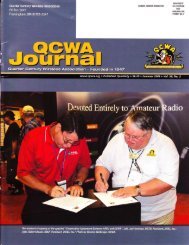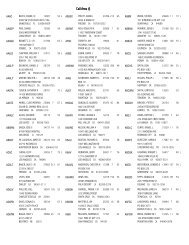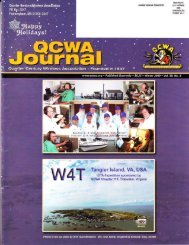G[mloulnal - Quarter Century Wireless Association
G[mloulnal - Quarter Century Wireless Association
G[mloulnal - Quarter Century Wireless Association
You also want an ePaper? Increase the reach of your titles
YUMPU automatically turns print PDFs into web optimized ePapers that Google loves.
Harolcl .f ohnson \\'2CHC<br />
ms Like Yesterday<br />
According to Harold<br />
:hnson, eighryyears as a<br />
ontinuously licensed<br />
lr radio operator has<br />
by so fast, that it<br />
like yesterday when<br />
Born in Florida in<br />
1905, he celebrated his<br />
nery-sixth birthday this<br />
and remains in good<br />
health. His family moved<br />
Yonkers, New York, in<br />
February 1905 for better<br />
portunities, when he<br />
one year of age. In<br />
Harold's late grammar<br />
school days around 1917,<br />
he became aware of that new invention called radio. Nearby in Yonkers<br />
there were ship-to-shore stations activiries - engaged in the business<br />
of communications. tWhen the United States entered the \Var<br />
in 1917, the Naly accelerated the use of communications benveen<br />
naval vessels and shore stations. The information about tlis was wideli,<br />
publicized and eventually filtered down to Harold and his grammar<br />
school friends.<br />
They were attracted to the mystery of this new scientific invendon,<br />
and the romantic idea of talking by code to each other. Harold<br />
says, he and his friends began to educate themselves on wireless by<br />
reading magazines that featured these scientific phenomena. Soon<br />
they understood the basics ofwireless and learned from others the<br />
capabiliry of the Ford auto spark coil. Best of all, these coils were<br />
readily available because the Ford auto was the leader in auto production.<br />
It wasn't long after this that Harold and his friends were building<br />
their own elementary spark coil stations for personal communications.<br />
It was a.lso 19 1 8 and the lWar had ended, and communications<br />
restrictions imposed by the US Nary for securiry were lifted.<br />
Not that it mattered much to Harold and his friends, because they<br />
knew little to nothing of the simple radio regulations and licenses of<br />
that period. They operated without licenses and practiced their code,<br />
and identified themselves by the initials of their names. They did not<br />
know it, but they had become "bootleggers". The term applied to<br />
iilegal liquor operations and seemed appropriate to apply to radio<br />
operators who didn't have a legal license . It is part of the folklore of<br />
amateur radio - now viewed with some amusement and nosta.lgia.<br />
Harold entered Yonkers High School where his wireless radio<br />
interest became evident to his instructors. One of them sought to<br />
offer advice in a well-meaning way, because Harold was not spending<br />
enough time on his studies, in hvor of wireless. He predicted<br />
that nothing good would come from wireless and that it lr,'ould soon<br />
fade away. As is common with teenagers of any period, Harold ignored<br />
the well-meant advice, for he knew better than his elders.<br />
Harold and his friends continued to operate spark without licenses,<br />
and in code.<br />
QCWA lournal - Summer 2001<br />
In the time period of 1920 and 1921 , Harold became aware of<br />
radio regulations of the time, and decided to obtain an amareur radio<br />
license. In the summer of 1 921, after he completed his sophomore year<br />
in high school, he visited the Radio Inspector (usually called the RI) at<br />
t}re federa-l building in NewYork Ciq,. Harold was successfiJ on the first<br />
try and shortly therefore was issued a cenificate of successfiJ accomplishment<br />
in tleory and code of ten words per minute. Among the<br />
sweral signatures on this certificate is that of Herbert Hoove! Jr., then<br />
Secretary of Commerce and later President of the United States. Harold<br />
still has fie large green colored certificate framed for display, and which<br />
proclaims to all in bold leners tlat HaroldJohnson is a Radio Operator<br />
First Class. The station license issued to him was 2CHC. The'W counuy<br />
prefr-x for t1-le United States was not part of the call sign ofthe period.<br />
After graduation fiom high school in 1923, Harold entered New<br />
York Universiry but later discontinued his formal education in favor of<br />
empioyrnent. In 1930 he married his sweetheart lois who was then a<br />
schoolteacher in Yonkers, and raised a family. They celebrated their sevenry-first<br />
wedding anniversary this year.<br />
In 1932 Harold enrolled in tle RCA Institute, and upon completion<br />
obtained a C-,ommercial Radio Operator License. He sought employment<br />
at various radio broadcast stations in the area during The<br />
Great Depression of the 1930s. later he.ioined the Sperry Gyroscope<br />
Company on long Island where he served as technician. After \forld<br />
War II he was employed by the ITT organization in NewJerseywhere<br />
he served in the new television equipment department. Harold and a<br />
technical team from ITT traveled to Buenos Aires, Argentina to install<br />
that city's firstTV station.<br />
In the 1960s Harold retired from ITT and moved the family to<br />
Clearwater, Florida. He was required to drop his call sign of \(2CHC<br />
by the regulations of that time, and was issued *re call sign K4G\ts.<br />
later in 1995 he was issued KU4HG as an Advanced Amateur licensee.<br />
Haroid felt a keen sense of loss by giving up his original call sign. \,X,4ren<br />
the Vanity Call Sign period arived, Harold applied for ald was reissued<br />
his original and first call sign. Thiswas averyhappymoment for Harold.<br />
During his leng*ry dme in amateur radio, Harold has been a member<br />
of many radio ciubs and electronic organizations. Among *re national<br />
organizations are the ARRL, OOTC, A\flA and QC\X/A with<br />
membership number 6 101 . He and his wife lois regularly amend all the<br />
meetings of the Florida Gator Chapter 32 of QC\7A<br />
Over the years his Ham station has changed with tle times, liom<br />
Spark to SSB, some items constructed and others bought. Curendy his<br />
station is located in his apartment on the nindr floor in an assisted living<br />
faciliry in Clearwater, Florida. It consiss of a Kenwood TS 820, and an<br />
all band dipole on the roof Look for him on his favorite 2O-meter band.<br />
His amateur friends in the Gator Chapter are very happy to recognize<br />
Harold's eighty continuous ysm as a licensed radio amateur. Harold<br />
says it would be 85 years if he were given credit for his unlicensed years.<br />
Croft Thylor \E3C[ Mce-president of QCVA, presented the hand-<br />
some plaque provided by QC\{zA to honor this old timer. This was<br />
plaque number 11. Nadona.l Directors of QCWA also in amendance at<br />
this ceremony on Saturday, January 6, 2001 were AIar Pickering KJ9N,<br />
Arthur Kunst'W3.{&{, andJohn Edel K8LBZ, Iong dme former Director.<br />
Congranrlations to you Harold from your many &iends in amateur<br />
radio. May you be blessed with continued good health, and many<br />
more years in amateur radio.<br />
Submitted by Artiur Kunst\73\7M



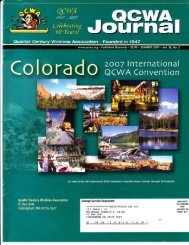
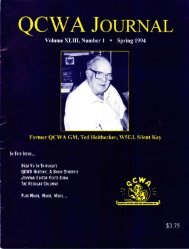
![11{J hI EfifSIt]E I]E - Quarter Century Wireless Association](https://img.yumpu.com/11816560/1/190x245/11j-hi-efifsite-ie-quarter-century-wireless-association.jpg?quality=85)
